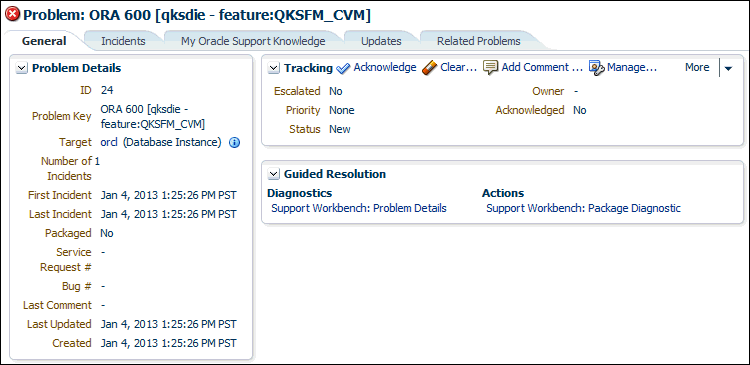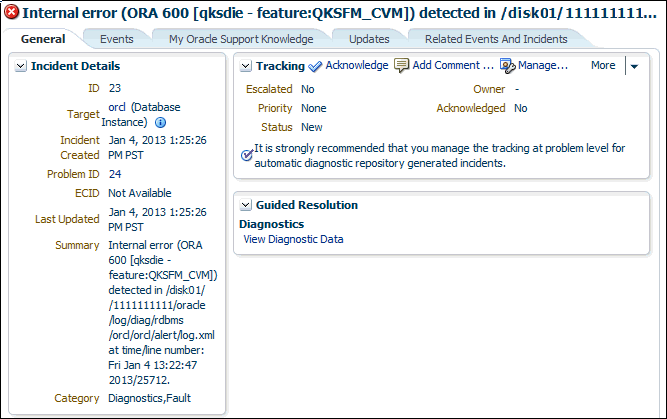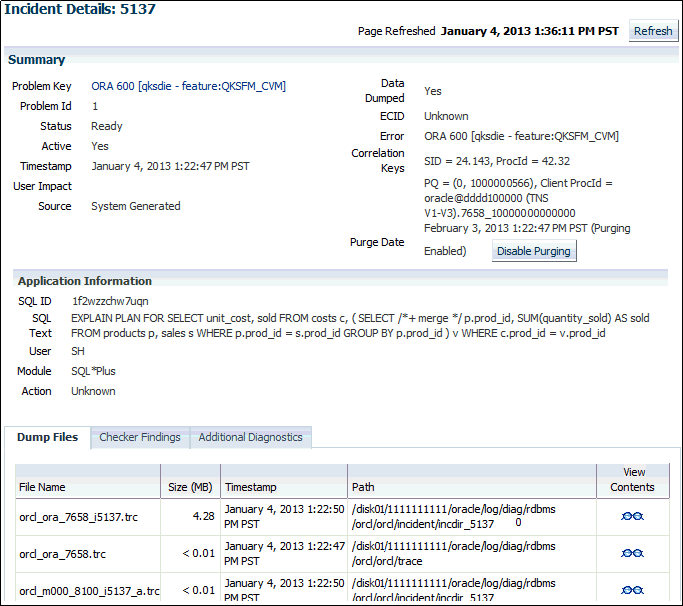17 Gathering Diagnostic Data with SQL Test Case Builder
A SQL test case is a set of information that enables a developer to reproduce the execution plan for a specific SQL statement that has encountered a performance problem. SQL Test Case Builder is a tool that automatically gathers information needed to reproduce the problem in a different database instance.
This chapter contains the following topics:
Purpose of SQL Test Case Builder
In many cases, a reproducible test case makes it easier to resolve SQL-related problems. SQL Test Case Builder automates the sometimes difficult and time-consuming process of gathering and reproducing as much information as possible about a problem and the environment in which it occurred.
The output of SQL Test Case Builder is a set of scripts in a predefined directory. These scripts contain the commands required to re-create all the necessary objects and the environment. After the test case is ready, you can create a zip file of the directory and move it to another database, or upload the file to Oracle Support.
Concepts for SQL Test Case Builder
This section contains the following topics:
SQL Incidents
In the fault diagnosability infrastructure of Oracle Database, an incident is a single occurrence of a problem. A SQL incident is a SQL-related problem. When a problem (critical error) occurs multiple times, the database creates an incident for each occurrence. Incidents are timestamped and tracked in the Automatic Diagnostic Repository (ADR). Each incident is identified by a numeric incident ID, which is unique within the ADR.
SQL Test Case Builder is accessible any time on the command line. In Oracle Enterprise Manager Cloud Control (Cloud Control), the SQL Test Case pages are only available after a SQL incident is found.
See Also:
-
Oracle Database Concepts for a conceptual overview of ADR
-
Oracle Database Administrator's Guide to learn how to investigate, report, and resolve a problem
What SQL Test Case Builder Captures
SQL Test Case Builder captures permanent information such as the query being executed, table and index definitions (but not the actual data), PL/SQL packages and program units, optimizer statistics, SQL plan baselines, and initialization parameter settings. Starting in Oracle Database 12c, SQL Test Case Builder also captures and replays transient information, including information only available as part of statement execution.
SQL Test Case Builder supports the following:
-
Adaptive plans
SQL Test Case Builder captures inputs to the decisions made regarding adaptive plans, and replays them at each decision point (see "Adaptive Plans"). For adaptive plans, the final statistics value at each buffering statistics collector is sufficient to decide on the final plan.
-
Automatic memory management
The database automatically handles the memory requested for each SQL operation. Actions such as sorting can affect performance significantly. SQL Test Case Builder keeps track of the memory activities, for example, where the database allocated memory and how much it allocated.
-
Dynamic statistics
Regathering dynamic statistics on a different database does not always generate the same results, for example, when data is missing (see "Dynamic Statistics"). To reproduce the problem, SQL Test Case Builder exports the dynamic statistics result from the source database. In the testing database, SQL Test Case Builder reuses the same values captured from the source database instead of regathering dynamic statistics.
-
Multiple execution support
SQL Test Case Builder can capture dynamic information accumulated during multiple executions of the query. This capability is important for automatic reoptimization (see "Automatic Reoptimization").
-
Compilation environment and bind values replay
The compilation environment setting is an important part of the query optimization context. SQL Test Case Builder captures nondefault settings altered by the user when running the problem query in the source database. If any nondefault parameter values are used, SQL Test Case Builder re-establishes the same values before running the query.
-
Object statistics history
The statistics history for objects is helpful to determine whether a plan change was caused by a change in statistics values.
DBMS_STATSstores the history in the data dictionary. SQL Test Case Builder stores this statistics data into a staging table during export. During import, SQL Test Case Builder automatically reloads the statistics history data into the target database from the staging table. -
Statement history
The statement history is important for diagnosing problems related to adaptive cursor sharing, statistics feedback, and cursor sharing bugs. The history includes execution plans and compilation and execution statistics.
See Also:
-
Oracle Database PL/SQL Packages and Types Reference to learn about the
DBMS_STATSpackage
Output of SQL Test Case Builder
The output of the SQL Test Case Builder is a set of files that contains the commands required to re-create all the necessary objects and the environment. By default, SQL Test Case Builder stores the files in the following location, where incnum refers to the incident number and runnum refers to the run number:
$ADR_HOME/incident/incdir_incnum/SQLTCB_runnum
For example, a valid output file name could be as follows:
$ORACLE_HOME/log/diag/rdbms/dbsa/dbsa/incident/incdir_2657/SQLTCB_1
You can specify a nondefault location by creating an Oracle directory and invoking DBMS_SQLDIAG.EXPORT_SQL_TESTCASE, as in the following example:
CREATE OR REPLACE DIRECTORY my_tcb_dir_exp '/tmp';
BEGIN
DBMS_SQLDIAG.EXPORT_SQL_TESTCASE (
directory => 'my_tcb_dir_exp'
, sql_text => 'SELECT COUNT(*) FROM sales'
, testcase => tco
);
END;
See Also:
Oracle Database Administrator's Guide to learn about the structure of the ADR repository
User Interfaces for SQL Test Case Builder
You can access SQL Test Case Builder either through Cloud Control or using PL/SQL on the command line.
Graphical Interface for SQL Test Case Builder
Within Cloud Control, you can access SQL Test Case Builder from the Incident Manager page or the Support Workbench page.
Accessing the Incident Manager
This task explains how to navigate to the Incident Manager from the Incidents and Problems section on the Database Home page.
To access the Incident Manager:
-
Access the Database Home page, as described in "Accessing the Database Home Page in Cloud Control."
-
In the Incidents and Problems section, locate the SQL incident to be investigated.
In the following example, the
ORA 600error is a SQL incident. -
Click the summary of the incident.
The Problem Details page of the Incident Manager appears.
The Support Workbench page appears, with the incidents listed in a table.
See Also:
-
Oracle Database Administrator's Guide to learn how to view problems with the Cloud Control Support Workbench
-
Online help for Cloud Control
Accessing the Support Workbench
This task explains how to navigate to the Incident Manager from the Oracle Database menu.
To access the Support Workbench:
-
Access the Database Home page, as described in "Accessing the Database Home Page in Cloud Control."
-
From the Oracle Database menu, select Diagnostics, then Support Workbench.
The Support Workbench page appears, with the incidents listed in a table.
See Also:
Online help for Cloud Control
Command-Line Interface for SQL Test Case Builder
The DBMS_SQLDIAG package performs tasks relating to SQL Test Case Builder. This package consists of various subprograms for the SQL Test Case Builder, some of which are listed in Table 17-1.
Table 17-1 SQL Test Case Functions in DBMS_SQLDIAG
| Procedure | Description |
|---|---|
|
|
Exports a SQL test case to a user-specified directory |
|
|
Exports a SQL test case corresponding to the incident ID passed as an argument |
|
|
Exports a SQL test case corresponding to the SQL text passed as an argument |
|
|
Imports a SQL test case into a schema |
See Also:
Oracle Database PL/SQL Packages and Types Reference to learn more about the DBMS_SQLDIAG package
Running SQL Test Case Builder
This tutorial explains how to run SQL Test Case Builder using Cloud Control.
Assumptions
This tutorial assumes the following:
-
You ran the following
EXPLAIN PLANstatement as usersh, which causes an internal error:EXPLAIN PLAN FOR SELECT unit_cost, sold FROM costs c, ( SELECT /*+ merge */ p.prod_id, SUM(quantity_sold) AS sold FROM products p, sales s WHERE p.prod_id = s.prod_id GROUP BY p.prod_id ) v WHERE c.prod_id = v.prod_id; -
In the Incidents and Problems section on the Database Home page, a SQL incident generated by the internal error appears.
To run SQL Test Case Builder:
-
Access the Incident Details page, as explained in "Accessing the Incident Manager".
-
Click the Incidents tab.
The Problem Details page appears.
-
Click the summary for the incident.
The Incident Details page appears.
-
In Guided Resolution, click View Diagnostic Data.
The Incident Details: incident_number page appears.
-
In the Application Information section, click Additional Diagnostics.
The Additional Diagnostics subpage appears.
-
Select SQL Test Case Builder, and then click Run.
The Run User Action page appears.
-
Select a sampling percentage (optional), and then click Submit.
After processing completes, the Confirmation page appears.
-
Access the SQL Test Case files in the location described in "Output of SQL Test Case Builder".
See Also:
Online help for Cloud Control







